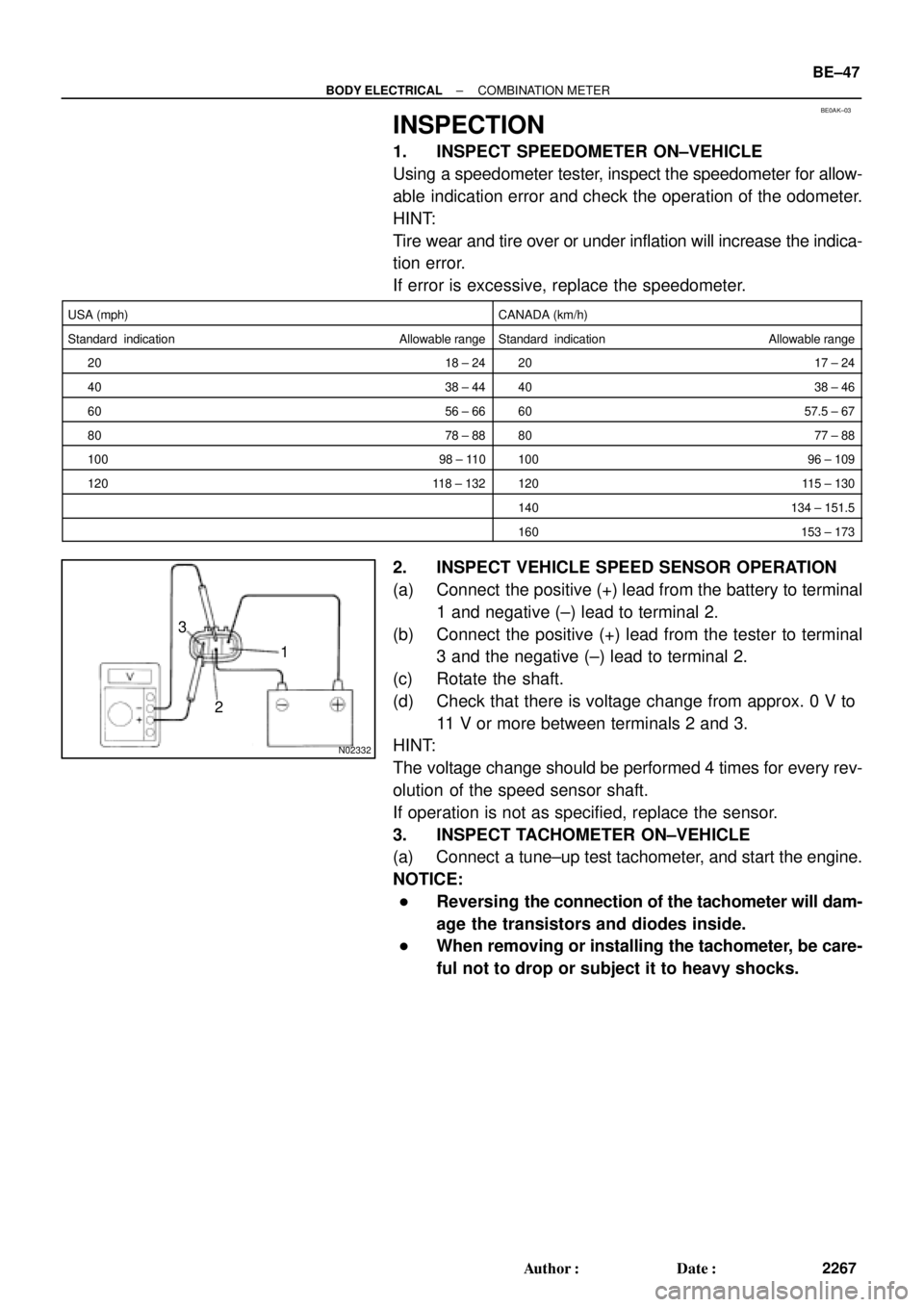Page 984 of 4770
'99camry U
188
ÐBlocking the wheel
2. Block the wheel diagonally opposite
the flat tire to keep the vehicle from
rolling when it is jacked up.
When blocking the wheel, place a wheel
block from the front for the front wheels
or from the rear for the rear wheels.
ÐRemoving wheel ornament
Steel wheels
Aluminium wheels
3. Remove the wheel ornament.
Pry off the wheel ornament, using the
beveled end of the wheel nut wrench as
shown.
CAUTION
Do not try to pull off the ornament by
hand. Take due care in handling the
ornament to avoid unexpected person-
al injury.
Page 985 of 4770

'99camry U
189
ÐLoosening wheel nuts
4. Loosen all the wheel nuts.
Always loosen the wheel nuts before rais-
ing the vehicle.
The nuts turn counterclockwise to loosen.
To get maximum leverage, fit the wrench
to the nut so that the handle is on the
right side, as shown above. Grab the
wrench near the end of the handle and
pull up on the handle. Be careful that the
wrench does not slip off the nut.
Do not remove the nuts yetÐjust unscrew
them about one±half turn.
ÐPositioning the jack
5. Position the jack at the correct jack
point as shown.
Make sure the jack is positioned on a
level and solid place.
ÐRaising your vehicle
6. After making sure that no one is in
the vehicle, raise it high enough so
that the spare tire can be installed.
Remember you will need more ground
clearance when putting on the spare tire
than when removing the flat tire.
To raise the vehicle, insert the jack handle
into the jack (it is a loose fit) and turn it
clockwise. As the jack touches the vehicle
and begins to lift, double±check that it is
properly positioned.
Page 986 of 4770
'99camry U
190
CAUTION
Never get under the vehicle when the
vehicle is supported by the jack
alone.
ÐChanging wheels
7. Remove the wheel nuts and change
tires.
Lift the flat tire straight off and put it
aside.
Roll the spare wheel into position and
align the holes in the wheel with the bolts.
Then lift up the wheel and get at least the
top bolt started through its hole. Wiggle
the tire and press it back over the other
bolts.Before putting on wheels, remove any cor-
rosion on the mounting surfaces with a
wire brush or such. Installation of wheels
without good metal±to±metal contact at the
mounting surface can cause wheel nuts to
loosen and eventually cause a wheel to
come off while driving. Therefore after the
first 1600 km (1000 miles), check to see
that the wheel nuts are tight.
Page 988 of 4770

'99camry U
192
ÐReinstalling wheel ornament
Steel wheels
Aluminum wheels
10. Reinstall the wheel ornament.
1. Put the wheel ornament into position.
On some models, align the cutout of the
wheel ornament with the valve stem as
shown.
2. Then tap it firmly with the side or heel
of your hand to snap it into place.
CAUTION
Take due care in handling the orna-
ment to avoid unexpected personal
injury.
ÐAfter changing wheels
11. Check the air pressure of the re-
placed tire.
Adjust the air pressure to the specification
designed in Part 8. If the pressure is low-
er, drive slowly to the nearest service sta-
tion and fill to the correct pressure.
Do not forget to reinstall the tire inflation
valve cap as dirt and moisture could get
into the valve core and possibly cause air
leakage. If the cap is missing, have a new
one put on as soon as possible.
12. Restow all the tools, jack and flat
tire securely.
As soon after changing wheels as pos-
sible, tighten the wheel nuts to the torque
specified in Part 8 with a torque wrench
and have a technician repair the flat tire.
CAUTION
Before driving, make sure all the
tools, jack and flat tire are securely
in place in their storage location to
reduce the possibility of personal in-
jury during a collision or sudden
braking.
Page 1002 of 4770

'99camry U
206
IN THE ENGINE COMPARTMENT
Items listed below should be checked
from time to time, e.g. each time when
refueling.
Washer fluid
Make sure there is sufficient fluid in the
tank. See Chapter 7±3 for additional in-
formation.
Engine coolant level
Make sure the coolant level is between
the ºFULLº and ºLOWº lines on the see±
through reservoir when the engine is cold.
See Chapter 7±2 for additional information.
Battery electrolyte level
Make sure the electrolyte level of all bat-
tery cells is between upper and lower lev-
el lines on the case. Add only distilled
water when replenishing. See Chapter 7±3
for additional information.
Brake fluid level
Make sure the brake fluid level is correct.
See Chapter 7±2 for additional information.
Engine oil level
Check the level on the dipstick with the
engine turned off and the vehicle parked
on a level spot. See Chapter 7±2 for addi-
tional information.Power steering fluid level
Check the level through the reservoir. The
level should be in the ºHOTº or ºCOLDº
range depending on the fluid temperature.
See Chapter 7±2 for additional information.
Exhaust system
If you notice any change in the sound of
the exhaust or smell exhaust fumes, have
the cause located and corrected immedi-
ately. (See engine exhaust cautions in
Part 2.)Be on the alert for changes in perfor-
mance, sounds, and visual tip±offs that
indicate service is needed. Some impor-
tant clues are as follows:
�Engine missing, stumbling, or pinging
�Appreciable loss of power
�Strange engine noises
�A leak under the vehicle (however, wa-
ter dripping from the air conditioning
after use is normal.)
�Change in exhaust sound (This may
indicate a dangerous carbon monoxide
leak. Drive with the windows open and
have the exhaust system checked im-
mediately.)
�Flat±looking tire; excessive tire squeal
when cornering; uneven tire wear
�Vehicle pulls to one side when driving
straight on a level road
�Strange noises related to suspension
movement
�Loss of brake effectiveness; spongy
feeling brake or clutch pedal;pedal al-
most touches floor; vehicle pulls to one
side when braking
�Engine coolant temperature continually
higher than normal
Does your vehicle need
repairing?
Page 1009 of 4770
'99camry U
243
Tires
Normal driving
kPa (kgf/cm2 or bar, psi)
Tire size
For all loads including full rated loadsFor reduced loads (1 to 4 passengers)
Wheel sizeTire sizeFrontRearFrontRearWheel size
P195/70R14 90S210 (2.1, 30)210 (2.1, 30)210 (2.1, 30)210 (2.1, 30)14�5.5JJ
P205/65R15 92H220 (2.2, 32)220 (2.2, 32)200 (2.0, 29)200 (2.0, 29)15�6JJ
Trailer driving
kPa (kgf/cm2 or bar, psi)
Tire size
FrontRear
P195/70R14 90S210 (2.1, 30)210 (2.1, 30)
P205/65R15 92H220 (2.2, 32)220 (2.2, 32)
When driving under the above vehicle load conditions at sustained high speeds above 160 km/h (100 mph), in countries where such
speeds are permitted by±law, inflate the front and rear tires to 240 kPa (2.4 kgf/cm2 or bar, 35 psi) provided that it dose not exceed
the maximum cold tire pressure molded on the tire sidewall.
Wheel nut torque, N´m (kgf´m, ft´lbf):
104 (10.5, 77)
Page 1014 of 4770

'99camry U
248
Uniform tire quality grading
This information has been prepared in ac-
cordance with regulations issued by the
National Highway Traffic Safety Adminis-
tration of the U.S. Department of Trans-
portation. It provides the purchasers and/
or prospective purchasers of Toyota
vehicles with information on uniform tire
quality grading.
Your Toyota dealer will help answer any
questions you may have as you read this
information.
DOT quality gradesÐAll passenger ve-
hicle tires must conform to Federal
Safety Requirements in addition to
these grades. These quality grades are
molded on the sidewall.
TreadwearÐThe treadwear grade is a
comparative rating based on the wear rate
of the tire when tested under controlled
conditions on a specified government test
course. For example, a tire graded 150
would wear one and a half (1±1/2) times
as well on the government course as a
tire graded 100. The relative performance
of tires depends upon the actual condi-
tions of their use, however, and may de-
part significantly from the norm due to
variations in driving habits, service prac-
tices and differences in road characteris-
tics and climate.Traction AA, A, B, CÐThe traction
grades, from highest to lowest, are AA, A,
B, and C, and they represent the tire's
ability to stop on wet pavement as mea-
sured under controlled conditions on spe-
cified government test surfaces of asphalt
and concrete. A tire marked C may have
poor traction performance.
Warning: The traction grade assigned to
this tire is based on braking (straight
ahead) traction tests and does not include
cornering (turning) traction.
Temperature A, B, CÐThe temperature
grades are A (the highest), B, and C,
representing the tire's resistance to the
generation of heat and its ability to dissi-
pate heat when tested under controlled
conditions on a specified indoor laboratory
test wheel. Sustained high temperature
can cause the material of the tire to de-
generate and reduce tire life, and exces-
sive temperature can lead to sudden tire
failure. The grade C corresponds to a lev-
el of performance which all passenger car
tires must meet under the Federal Motor
Vehicle Safety Standard No. 109. Grades
B and A represent higher levels of perfor-
mance on the laboratory test wheel than
the minimum required by law.Warning: The temperature grades for this
tire are established for a tire that is prop-
erly inflated and not overloaded. Exces-
sive speed, underinflation, or excessive
loading, either separately or in combina-
tion, can cause heat buildup and possible
tire failure.
Page 2141 of 4770

BE0AK±03
N02332
1
2 3
± BODY ELECTRICALCOMBINATION METER
BE±47
2267 Author�: Date�:
INSPECTION
1. INSPECT SPEEDOMETER ON±VEHICLE
Using a speedometer tester, inspect the speedometer for allow-
able indication error and check the operation of the odometer.
HINT:
Tire wear and tire over or under inflation will increase the indica-
tion error.
If error is excessive, replace the speedometer.
USA (mph)CANADA (km/h)
Standard indication Allowable rangeStandard indication Allowable range
20 18 ± 24 20 17 ± 24
40 38 ± 44 40 38 ± 46
60 56 ± 66 60 57.5 ± 67
80 78 ± 88 80 77 ± 88
100 98 ± 110 100 96 ± 109
120 118 ± 132 120 115 ± 130
140 134 ± 151.5
160 153 ± 173
2. INSPECT VEHICLE SPEED SENSOR OPERATION
(a) Connect the positive (+) lead from the battery to terminal
1 and negative (±) lead to terminal 2.
(b) Connect the positive (+) lead from the tester to terminal
3 and the negative (±) lead to terminal 2.
(c) Rotate the shaft.
(d) Check that there is voltage change from approx. 0 V to
11 V or more between terminals 2 and 3.
HINT:
The voltage change should be performed 4 times for every rev-
olution of the speed sensor shaft.
If operation is not as specified, replace the sensor.
3. INSPECT TACHOMETER ON±VEHICLE
(a) Connect a tune±up test tachometer, and start the engine.
NOTICE:
�Reversing the connection of the tachometer will dam-
age the transistors and diodes inside.
�When removing or installing the tachometer, be care-
ful not to drop or subject it to heavy shocks.